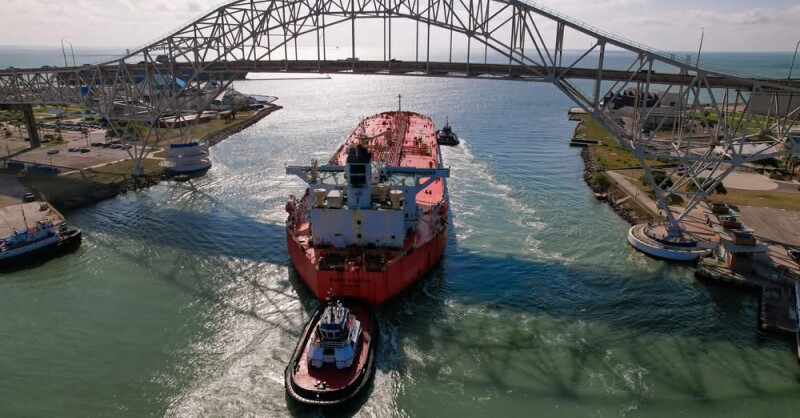The Port of Corpus Christi hosted a ribbon cutting celebration with federal, state, and local leaders this week, marking the near completion of a decades-long project to deepen and widen the Corpus Christi Ship Channel — a development seen as a key step in enhancing U.S. energy export capabilities.
The $625 million Corpus Christi Ship Channel Improvement Project (CCSCIP), initiated in 2017, improved approximately 11.9 miles of channel and is now in its final stages. When completed, the project will have increased the depth of the ship channel from 47' to 54' mean lower low water and widened it from 400' to 530', with added barge shelves. The improvements will allow for safer, two-way traffic and accommodate larger, modern vessels transporting crude oil, liquefied natural gas (LNG), and other commodities.
"This accomplishment is only possible because of the steadfast support and cooperation of our non-federal partner, the Port of Corpus Christi,” said Col. Rhett Blackmon, the Commander for the U.S. Army Corps of Engineers (USACE) Galveston District. “Along with the port, stakeholders like the Texas General Land Office, and the Coastal Bend Bays and Estuaries Program advocate for the communities we serve. In collaboration, we were able to deliver one of the largest beneficial use projects in the history of our district.”
Originally conceived over 30 years ago, the project was jointly funded by the U.S. Congress and the port itself, with support from USACE and private sector marine firms. Officials credit the success of the effort to robust public-private partnerships, which they say offer a model for future infrastructure development.
“All of this has been possible through extraordinary partnership. The Port of Corpus Christi Authority has been more than a non-federal sponsor — they’ve been a proactive, dedicated champion of this project since the very beginning,” said Brig. Gen. George Walter, the USACE Southwestern Division commander. “When federal funding was delayed, the port stepped up with advanced funds to ensure we could break ground without missing a beat. That level of commitment speaks volumes about their leadership and vision.”
"My fellow commissioners and I are grateful to the administrations and congressional delegations who supported this initiative, as well as the Port of Corpus Christi staff — past and present — who worked diligently to make this vision a reality. The Corpus Christi Ship Channel Improvement Project unlocks a new era of economic growth for both the Coastal Bend and the nation,” said David Engel, chairman of the Port of Corpus Christi Commission. "This commitment represents what can be achieved when we work toward a common goal: driving prosperity at home and strengthening America’s leadership in the evolving global market."
Economic impacts are already being felt. The improved infrastructure is expected to generate annual transportation cost savings exceeding $200 million. Additionally, the port's proximity to the prolific Eagle Ford Shale and Permian Basin formations has attracted more than $65 billion in commercial investments over the past decade. Port-related operations now support more than 95,000 jobs across Texas.
The Port of Corpus Christi is an important energy hub, serving as the largest crude oil export gateway in the U.S. and the third-largest globally. It handles over 2.4 million bbls. of crude oil per day for export and is also the second-largest U.S. exporter of LNG.
BENEFICIAL USE
About 5 million cu. yards of dredged material from the CCSCIP went into restoring marshes in the Corpus Christi and Nueces bays.
The overall channel improvement project will combat erosion within the channel by providing 395 acres of sacrificial erosion protection along with the construction of a 2,000' breakwater — to tie into a planned 4,000' breakwater — in the Nueces Delta.
“This project was a successful endeavor that highlights what can be accomplished when the ports and federal agencies work together,” said Harmon Brown, the USACE project manager overseeing the CCSCIP. “The beneficial use sites were the result of close cooperation with local non-government organizations and USACE to achieve ecosystem restoration on a scale that will reap real benefits for years to come.”




